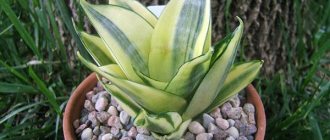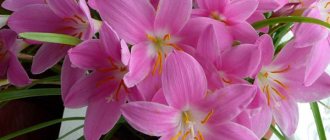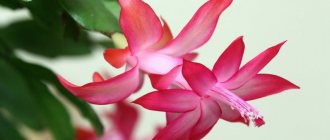Ruscus is a plant that is not very popular among flower growers and is rarely found in our homes. It’s a shame, because butcher’s broom can not only decorate the interior, but also bring practical benefits to its owner. Firstly, broom is considered a medicinal plant, secondly, with the help of broom branches you can create spectacular flower arrangements, and, finally, broom is perfect for the role of a Christmas talisman: thin shoots look like Christmas tree needles, and bright red berries decorate them like New Year's ones toys.
If broom already lives in your home or you want to purchase it, find out more about it.
Butcher's broom, ruscus, or mousethorn (popular name) - this plant is part of the Asparagus family (Asparageceae). In some sources, a separate Iglitsev family is identified or included in the Liliaceae. The birthplace of the culture is considered to be the Crimea peninsula, the Caucasus and the Mediterranean. In the wild, broom prefers coniferous forests, hiding in the partial shade of large trees.
This is an evergreen subshrub or shrub with a creeping rhizome, bluish-green in color, and can reach a height of up to one hundred centimeters. The stems are finely grooved, erect, finely rough along the ribs. The flowers are small in size, located in the lower part of the phylloclades (modified leaves) of a small lanceolate bract. The fruits are red, two-seeded, 8–10 mm in diameter.
[!] What we are used to thinking of as broom leaves are actually its shoots, the so-called phyllocladies. True leaves are small and scale-like.
The berries (fruits) of butcher's broom are very decorative and are a real decoration of the plant. Unfortunately, berries rarely appear at home: butcher's broom is a dioecious plant, which means that male and female specimens are needed for the ovaries. However, in some cases, one plant can bear fruit.
About the plant
Iglitsa has the second name Ruskus. Different types of butcher's broom vary in height and appearance. The shrub by nature does not shed its leaves every year. The leaves are not really leaves, they are shoots, and the actual leaves are small and like scales.
The butcher's broom is decorated with its berries, but it is extremely rare to see them at home, they rarely appear at home, they are pollinated by insects, after which a red berry appears.
Diseases and pests
Ruscus is a hardy shrub and is rarely susceptible to disease. Often the cause of plant disease is improper care. Overmoistening of the soil can lead to rotting of the roots of the broom, and insufficient moisture can lead to drying out.
Among the pests, the greatest danger to the plant are scale insects and spider mites. To get rid of them, the entire plant is treated with an insecticide solution. When processing shrubs, you should follow the instructions and safety rules.
Ruscus is a very beautiful plant and quite rare. Some species are listed in the Red Book. Therefore, the owners of this plant will not only enjoy the beauty, but will also prevent their complete disappearance.
How to care
Ruscus is used for landscaping garden plots and squares. It is a misconception that a houseplant is difficult to care for, that it requires some special care and attention, let's see if this is actually true.
Before you start caring for butcher’s broom at home, you need to familiarize yourself with some rules, which will include several points:
What kind of light should there be? This plant feels better when there is little sun, which means it needs to be placed in the shade. In winter, it is best, if possible, to place it on a windowsill facing south. In hot weather, it is recommended to place it in a darker place, because direct sunlight can damage the leaves.
What should the air humidity be? In spring and summer, you need to maintain the temperature in the range of 18-20 degrees. The temperature decrease should occur in the fall. In winter it should vary from 13 to 15 degrees.
The plant can easily tolerate drafts and temperature changes. You don’t have to pay much attention to the humidity in the room, because this type of plant tolerates dry air well.
How to water a flower - when the growing season occurs, you need to monitor constant watering, flowers can usually be watered infrequently, and before shoots begin to appear, systematically, when they form, you can reduce the amount of watering. It is necessary not to overdry the soil.
How to fertilize - during the winter season, the broom is dormant and there is no need to fertilize; fertilizers must be available and applied to the soil from spring to late autumn.
What the soil should be like - not too dense a substrate, this can lead to water accumulation.
Medicinal properties
Ruscus is a medicinal plant. It can be used in preparations for:
- Constriction of blood vessels.
- Strengthening veins.
- Reducing capillary fragility.
- Increased muscle tone.
- Metabolism improvements.
- Improves blood circulation.
- Diagnosis of inflammation.
- Reducing the risk of blood clots.
That is, the plant is used primarily for the prevention of diseases associated with the circulatory system.
Growing, transplanting
Growing at home does not require much difficulty or effort. You just need to adhere to the rules that are written above, they will not allow you to make mistakes in the process of caring for butcher's broom and it will delight the eye with its beautiful appearance.
What do you need to know when growing this plant? First of all, you need to know how to transplant correctly and know how these plants reproduce.
In order for your plant to grow into a wonderful flower, it is better to replant in the spring; this time of year is the most successful and favorable for butcher's broom. It is worth replanting when the plant has grown too much, and the size of the pot in which the replanting will take place must be adjusted to the size of the current one.
If you don’t want the bush to have fluffiness as a decoration, then choose a narrow pot. To prevent water from stagnating during irrigation, it is recommended to make the bottom layer from drainage. Feeding should be done once every three weeks.
Landing
The plant is planted mainly by seeds. A lower drainage layer of soil is made to avoid stagnation of water. Deciduous soil and sand are used as soil. Be sure to water the seeds after planting. The sprout will appear in a couple of months and can be transplanted to a permanent location.
Ruscus can also be grown in open ground. It is recommended to choose a place under a tree so that there is enough shade in summer and sun in winter. The seeds are planted directly into the ground and watered. Butcher's broom is unpretentious to temperature and soil, so the chance that it will grow outside is quite high.
Butcher's broom - the popular name for ruscus
Reproduction
Butcher's broom reproduces using rhizomes and seeds.
Butcher's broom seeds should be placed in a container with water, glass should be placed on top, and placed in a lighted place. The first sprouts will appear in 2-3 months, the first fruit in a year. You can also do the second propagation method with seeds.
To do this, the seeds are placed in a special mixture of peat and perlite and placed in a room where the air is 20 degrees. Planting into separate pots should be done if they have grown to their maximum capacity.
Dividing the rhizome is most favorable; it helps with strong plant growth, in which it is difficult to continue development further. To do this, they cut it with a sharp knife, dividing it into parts, pieces that have many shoots and a root system.
With this type of propagation, transplantation should occur in autumn or spring, at which time it does not grow so quickly. When replanting, you need to avoid quick and careless movements; they can aggravate the situation and harm the growing shoots.
Application in cosmetology
Ruscus-based cosmetic products have been successfully used for many years. The plant can effectively treat rosacea, a disease characterized by the appearance of dilated capillaries on the skin. It occurs due to poor circulation. The effectiveness of the plant is due to its antiseptic and anti-inflammatory effect. Ruscus is also capable of destroying bacteria. Moreover, treatment is not limited to eliminating symptoms; the plant can also eliminate the causes of the disease.
Don't forget about the ability of butcher's broom to fight cellulite. The plant activates blood circulation, improves metabolic processes and stimulates cell regeneration. It also helps to successfully fight stretch marks.
To improve skin condition, you can use plant extract. Pharmacies sell it ready-made, but you can make it yourself. There are two types of extract:
- Macerate.
Translated from Latin it means “soaked”. It is obtained by soaking the plant in a liquid (water, alcohol, oil). - Infusion
This is the process of extracting nutrients from a plant using liquid.
The second method is used more often than others. To prepare the extract, you will need berries or plant roots. Flowers are also sometimes used. Then heat the liquid (without bringing it to a boil) and pour the raw materials into it, then leave for several hours. The infusion must then be strained and stored in bottles. It can be added to cream or shampoo.
You can also add fresh berries to cosmetics. To do this, you need to peel them, remove the seeds, then crush them into a paste and add them to a cream for your hands, feet or face. This cream can be used to lubricate the circles around the eyes.
For heaviness in the legs, varicose veins and other problems, you will need an extract from the roots of butcher's broom. It can be used as a stand-alone remedy, applying compresses to the sore spot, or in combination with foot cream. At the same time, you need to mix the extract with the cream to maintain a thick consistency.
Traditional healers advise lubricating the skin around the eyes with the juice of fresh berries. They can also be eaten.
The extract is also successfully used in the fight against cellulite. To do this, you need to lubricate problem areas with an extract from the roots of the plant in water.
We recommend reading:
use of bait in cosmetology
Read
Benefit
Ruscus bush is now widely used for many diseases. Creams, ointments, and gels are made from the plant. They are especially used in medicine; creams are very effective in dilating veins.
Traditional medicine also uses this type of plant, the rhizome and fruits of butcher's broom are beneficial, the berries are used in treatments for jaundice, the rhizome is used for infusions that eliminate headaches, gout, relieve swelling, and relieve gangrene.
In alternative medicine, they have taken a broader approach to using the plant, for example, it is a binding element in the production of drugs, the medicinal properties of ointments and creams. The fruits of the bush also help purify the blood.
Usage
Ruscus is used to decorate rooms. Its bright foliage and scarlet berries are good at any time of year. Bushes are suitable for landscaping rooms, cold foyers and public institutions. Bushes covered with berries can be given as a gift instead of a bouquet. Cut stems are also used to make bouquets.
The roots and berries of ruscus have medicinal properties. The dried raw material is brewed and taken orally to combat hemorrhoidal manifestations, strengthen veins and combat blood stagnation in the lower extremities.
Kinds
Here we present the types of butcher's broom plant; we will describe the plant itself and the flowers.
Butcher's broom is resistant to cold and frost, red berries appear in the fall, mainly on female bushes; there are flowers of both sexes. The size of the flowers is small.
Butcher's broom is not very long, has a dark green color, the berries are predominantly bright red, blooms in spring, and bears fruit from July to December.
Butcher's broom - has a straight stem and even branches, small purple flowers, its fruit is red. It blooms from autumn to winter, bears fruit from late autumn to late winter.
Butcher's broom - tolerates shade well, is not a very low plant, the leaves are narrow towards the end, have a shine and are oblong in shape.
Hyrcanian broom - appears and spreads in forests, where there are mountains, which can result in a lush cover.
Butcher's broom - this species has straight stems and large leaves. Flowers begin to appear in autumn and winter, fruits begin to ripen in spring. Colchis butcher's broom is used for medicinal purposes.
Trimming
For butcher's broom, this agrotechnical technique is not mandatory. It is carried out only if there is a need to remove dried parts of the bush or to maintain a certain shape.
Sanitary pruning is usually combined with shaping pruning. This process involves:
- removal of damaged or dried shoots;
- shortening those that stand out from the outline of the form;
- thinning the bush if necessary.
Important! Pruning can be done at any time except during the dormant period.











